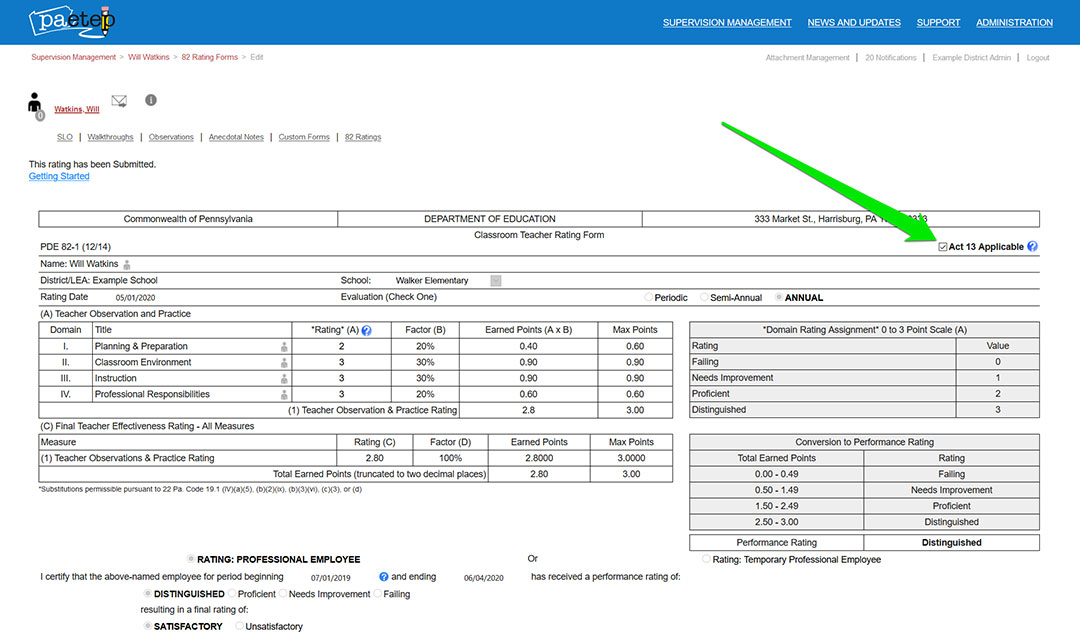During this unprecedented time, we understand you are working under a “new normal” and adjusting to teaching and supporting your students and faculty virtually. Edulink is committed to partnering with you to help you through this transition. Provided below are a few ideas and resources that we hope will assist you during this time.
82 Forms Update – Electronic Signatures Feature!
The electronic signature feature is now available on all 82 forms in PA-ETEP! Visit our support article – 82 Forms and Electronic Signatures to learn how to use this valuable addition to the software.
NEW Act 13 Update
All 82 forms in PA-ETEP have been programmed to adhere to the new Act 13 requirements set forth by the PDE. Supervisors can simply click on the Act 13 Applicable box in the top right corner of the 82 form, and it will automatically calculate the final score based solely upon the Observation and Practice section (see the image below). For more details on completing the forms, visit our support article (Completing 82 Forms for the 2019-20 School Year).
Click screen to enlarge.
Online Educator Rubric
An Online Educator Rubric is now available within PA-ETEP for educators who are teaching online. The rubric was developed through a collaboration of various intermediate unit administrators across the state. The Online Educator rubric can be used as a part of a Formal Observation, Differentiated Observation, NTPE Observation, and/or either of the Stand Alone rubrics (Teacher Only or Teacher/Principal) within PA-ETEP. To support districts, the Online Educator Rubric has been applied to all PA-ETEP users with the Teacher Role. Moving forward, building principals and supervisors can choose which rubric (the traditional Teacher Rubric or the Online Educator Rubric) they would like to use when evaluating and working with a teacher. A pdf version of the rubric can also be shared with teachers for guidance. To review and learn more about this rubric, review the PA-ETEP support article linked below.
Anecdotal Notes
Anecdotal Notes are a component of PA-ETEP whereby users can share and document a variety of information. Teachers/NTPEs can use Anecdotal Notes to share evidence and artifacts with their supervisors. For example, now that educators are teaching and communicating with students online, teachers can use Anecdotal Notes to share lesson plans, activities, assessments, and communications with their supervisors. Supervisors can then review evidence and comment back, providing feedback and guidance as needed. Both teachers and supervisors have the ability to start Anecdotal Notes. To start an Anecdotal Note, teachers simply log into their PA-ETEP portal, go to their My Observations page, scroll down to the Anecdotal Note section, and click Create New. Once initiated, teachers can select their supervisor and share information. Teachers and supervisors can comment back and forth as much as needed.
Stand-Alone Rubrics
If you are looking for a streamlined way to document evidence and/or provide component ratings, consider using PA-ETEP’s Stand-Alone rubrics. Stand-Alone rubrics are exactly that, they are comprised of only the rubric part of traditional observations whereby the teacher and/or principal can rate on all 22 components and add component specific comments where appropriate. Stand-Alone rubrics can be used with teachers and non-teaching professionals (NTPEs) like counselors, nurses, etc.
Attachments
If you have the attachment module enabled on your portal, you can upload documents, images and audio files to any comment box section throughout PA-ETEP. Learn more about how to use the attachment module below.
Logging in From Home
As you navigate working from home, you may not have your password easily accessible or may need to reset it in order to log into PA-ETEP. Take a look at the article below for step-by-step instructions for resetting your password.

